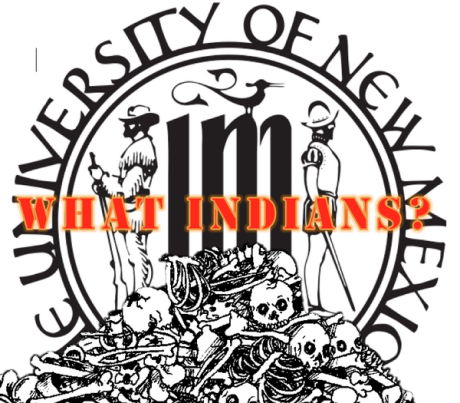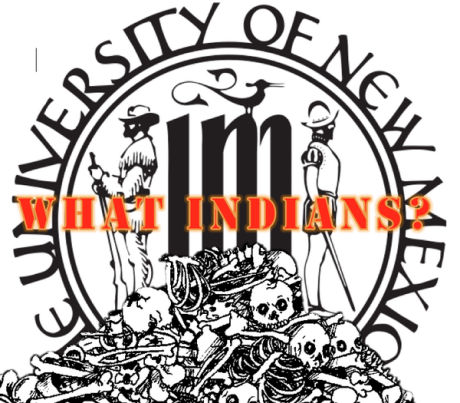This talk was given March 3, 2016 as part of the Indigenous Book Festival’s opening roundtable, “Beyond Stereotype, Prejudice, & Racism,” at the University of New Mexico, Albuquerque.

I want to make two simple claims: 1) The University of New Mexico profits from the genocide of Indigenous peoples and the occupation of Indigenous lands. 2) UNM’s official seal celebrates this fact.
Originally designed in 1909 by President Edward Gray and officially adopted in 1914, the seal represents what one alumni publication calls “two New Mexico founders, a Spanish conquistador and a frontiersman.” Back-to-back figures of two men armed with the weapons of conquest (a sword and musket) join other seemingly innocuous images, symbols, and rituals—the Lobo, the Alma Mater, the school colors red and silver—that make a university a university, a kind of identity and brand that creates an image of UNM as identifiable and characteristically distinct. According to the Administrative Policies and Procedures Manual’s section on the University’s graphics and symbols, “A cohesive visual identity presents a sense of unity and builds awareness and pride among those connected to [UNM].” “The most formal symbol of the University,” it continues, “is the seal. The seal is reserved for use on documents or forms of the highest official rank from the University President, the University Secretary, and the University Board of Regents such as diplomas, certificates, certain invitations, legal documents, and other printed materials. Use of the seal must be approved in advance, by the University Marketing Director.”
Its most basic definition: a seal as a design or insignia plays the official role of representing an organization, an institution, or political entity (like a city, state, or nation). It originated as a stamp to impress an image or sign of authority into wax as a way of securing, authenticating, and approving. Seal derives from the Latin signum. When used as a verb, signum means to mark or to sign. In its formal, ceremonial usage, it becomes a symbolic act representing power and authority. For a sovereign, it embodies the will of a ruler over the ruled, or the power over life itself, the power to mark those deserving life and those deserving death. Wars, executions, diplomatic treaties for peace and trade all bear the marks of seals. Even the banality of bureaucracy, from letters to official statements to press releases, bears the marks of seals. The seal, too, is used like a brand to mark property, much like one brands cattle. It is also a form of possessiveness, embodying and laying claim to the what is and is not part of the official order of things. In this sense, it plays a role of inclusion and exclusion.
If a seal is an impression of power, then, the seal of UNM is an impression a history that gives it authority. And that history is one marked by violence, dispossession, and death. Like much paraphernalia relating to power and authority, the masculine figures armed with sword and musket personify just how order and civilization was achieved in the founding of New Mexico—through violence. Spanish colonization entailed the rape, murder, enslavement, and torture of Indigenous peoples at the hands of conquistadors such as Oñate and de Vargas. The expulsion of the Spanish from Indigenous homelands during the 1680 Pueblo Revolt and their subsequent return were was marked by extreme persecution and prejudice towards Indigenous peoples. Nonetheless, subsequent Mexican independence was also filled with further persecution and oppression. The conclusion of the U.S.-Mexican War and the 1848 Treaty of Guadalupe Hidalgo revealed the true intentions of U.S. and Mexican colonial policy toward Indigenous peoples. The U.S. violated almost every treaty article before the ink was dry, but both the U.S. and Mexico did, however, uphold Article XI, which guarantees that “incursions” into either nation on behalf of the “savage tribes” inhabiting the newly acquired territory would be met with force of “equal dilligence [sic] and energy” by both nations. Indeed, U.S. domination was equally, if not more, brutal and punishing than its progenitors. From forced marches and open air concentration camps for Navajo and Apache prisoners of war at Bosque Redondo, from Indian fighters and Indian killers such as Kit Carson and William Tecumseh Sherman, to mass enclosures and privatization of unneeded Indigenous lands, the early U.S. colonial period in New Mexico is replete with examples of Indigenous genocide and dispossession.
As a fledgling territory, the founding of the University of New Mexico played a pivotal role in the path towards statehood. Founded in 1889 amidst federal Indian policy that advocated the fragmentation of tribal land and the stealing of Indian children from families to be forced into boarding schools, UNM was originally granted acreage as Trust Land, much like many territorial universities in the so-called Western frontier. The subduing and dispossession of Indigenous peoples during this time is largely lamented due to the closing of the frontier; yet out of this unspeakable violence was borne UNM and the state of New Mexico. The 1910 New Mexico Enabling and Ferguson Acts granted the state 13 million acres of Trust Land. Of which, 200,000 acres were granted to public universities like UNM. In total, 5 million acres were reserved for universities, schools, and other institutions. Of the now 9 million surface acres and 12.7 million subsurface acres of Trust Land, about 96% of value extracted from these lands coms from non-renewable resources like oil, gas, and coal. This highly lucrative business attracts over 9,500 oil and gas leases and 166 mineral leases that cover 3.1 million acres for a value of $433 per acre. For fiscal year 2013, revenue generated from these land at a sum of $577 million realized its second highest earning year, down from 2012’s record-setting $658 million. As of 2013, UNM directly benefits from 253,336 surface acres and 344,821 subsurface acres of public Trust Land. From these lands, UNM earned $8.5 million.
If we return to how UNM brands itself to create “a sense of unity and pride,” we can begin to think of various ways in which the University narrates itself and its history, how it tells its story. The UNM seal tells a story, too—a story that is celebratory of the anti-Indian violence forged within the University’s history and how it benefits from the dispossession of Indigenous lands. What is perhaps most insidious about the commemoration of colonial conquest is its celebration of two essential actors and perpetrators of genocide—a conquistador and frontiersman—and the sacred and sanctimonious status the seal holds for its alumni and benefactors. As much as the assault on the racist imagery of Indian mascots is seen as a direct assault on the sanctity of whiteness (and settlers) to possess and lay claim to Indigenous lands and bodies, defacing and interrupting the colonial narratives of a university seal will, too, be seen as an assault on a “tradition” and the sanctity of possessive whiteness. But what this “tradition” celebrates and what this sacredness protects can categorically be defined as anti-Indian, or explicitly Indian hating. The stakes are high to talk openly and fluently about colonization and occupation. To do so creates an uncomfortable space of overwhelming hostility and tension. History, after all, is the past’s saturation of our present moment. It cannot be ignored. But to bring it up is to bring it into existence as something to be “dealt with.”
It is not by accident that the lands stolen by the figures consecrated on UNM’s crest—the conquistador and the frontiersman—created a source of revenue for the University. The University, in this case, literally profits from the dispossession and death of Indigenous peoples. Changing the racist-colonial celebration of the seal, however, will not rid the University of this pervasive history of violence and dispossession, nor will it change colonial, racist behavior. What I have been talking about so far is the colonial structures of power, premised on genocidal conquest and Indigenous erasure. The violence of colonial occupation and dispossession is not only fundamental to UNM’s being, but it is also reimagined as a history of securing freedom and rights—freedoms for some and unfreedom for others. It permeates the University even as it actively denied and ignored. But it is not my intention to blame the University, nor its constituency, for the wrongs of the past. While UNM is not responsible for the past crimes of its forbearers, our present reality is a product that history, and for that the University has to be held accountable if it perpetuates and, indeed, celebrates the destruction and attempted annihilation of the original people of this land.
That’s why the very least the University can do is to abolish the racist seal. Recently, a committee of Harvard Law School faculty, students, alumni, and staff recommended that school’s crest—which was modeled on the family crest of a slaveholding family—be retired. Across university campuses movements have galvanized to abolish symbols that celebrate racism—such as Confederate flags and icons of slavery. Abolishing these symbols of oppression, however, only revealed institutionalized inequality. Changing university iconography means nothing, we were told, if it is not accompanied by real, material resources—such as scholarships, the creation and funding of diversity centers, and equal representation at all levels of the university system including the board of regents. This is bare minimum accountability. As we have seen, some administrators at these institutions lost their jobs for upholding and defending status quo inequality. It was only after student protest and sit-ins did these universities capitulate. At UNM, we are reminded by the administrators’ utter neglect and disdain to institute Indigenous Peoples Day as an official holiday after successful undergraduate organizing in passing a resolution. Universities are supposed to be bastions of free thought and progressive politics. If anything, UNM administrators’ neglect of Indigenous students and demands demonstrates classic reactionary and backwards thinking on Indigenous issues and concerns. One needs to only look at the national movement to see how cities and institutions across the nation have already implemented Indigenous Peoples Day, including the city of Albuquerque.
In conclusion, as Indigenous peoples we must refuse to allow our educational achievements (some of us as first generation graduates and doctorates) to be tarnished by UNM’s unwillingness to enter the twenty first century and to respect the basic fundamental of human rights standards. That is, colonialism and genocide are crimes against humanity and so too is their celebration. World consensus agrees. We demand this seal be abolished and the Indigenous peoples of this land receive accurate and appropriate representation. We do not want this insidious racism branding our accomplishments on our degrees and graduation gowns. We, as Indigenous peoples, do not belong in museums. This university’s racist history does. Hecetu welo!

